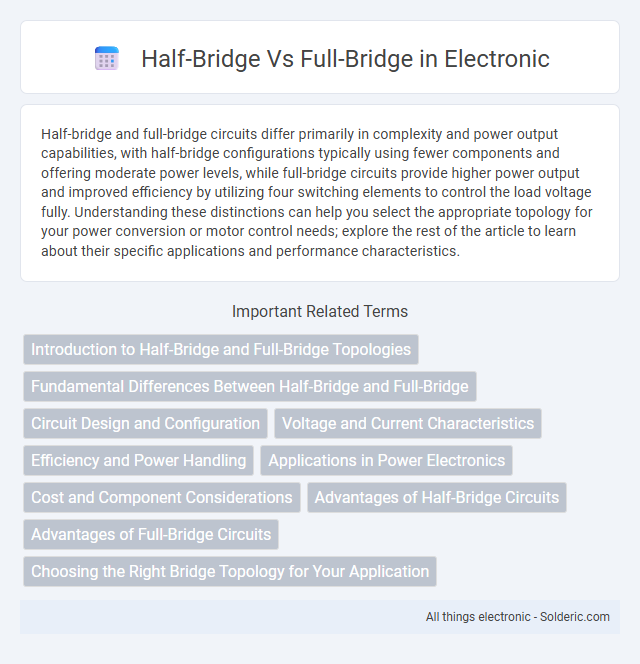Half-bridge and full-bridge circuits differ primarily in complexity and power output capabilities, with half-bridge configurations typically using fewer components and offering moderate power levels, while full-bridge circuits provide higher power output and improved efficiency by utilizing four switching elements to control the load voltage fully. Understanding these distinctions can help you select the appropriate topology for your power conversion or motor control needs; explore the rest of the article to learn about their specific applications and performance characteristics.
Comparison Table
| Feature | Half-Bridge | Full-Bridge |
|---|---|---|
| Configuration | Two switches arranged in series | Four switches arranged in an H-bridge |
| Output Voltage | Up to half of supply voltage | Full supply voltage across load |
| Power Handling | Lower power capacity | Higher power capacity |
| Cost | Less expensive hardware | Higher cost due to more components |
| Complexity | Simple circuit design | More complex circuit and control |
| Applications | Low to medium power DC-DC converters | Motor drivers, full control of load |
| Efficiency | Moderate efficiency due to half voltage swing | Higher efficiency with full voltage swing |
Introduction to Half-Bridge and Full-Bridge Topologies
Half-bridge and full-bridge topologies are fundamental configurations in power electronics, primarily used in DC-AC inverters and motor drives. A half-bridge employs two switches and capacitors to convert DC to AC with reduced component count, while a full-bridge utilizes four switches to provide full control over output voltage polarity and higher efficiency. Understanding your application requirements will determine if the simpler half-bridge or the more versatile full-bridge topology is the best fit.
Fundamental Differences Between Half-Bridge and Full-Bridge
Half-Bridge and Full-Bridge converters differ fundamentally in their configurations and applications. A Half-Bridge uses two switches and two capacitors to create a voltage divider, providing simpler control and lower component count, ideal for moderate power levels. Full-Bridge circuits utilize four switches to allow full voltage utilization across the load, offering higher power output and greater efficiency, making them suitable for demanding applications where Your power requirements are critical.
Circuit Design and Configuration
Half-bridge circuits use two switches and a midpoint connection to control voltage output efficiently, making them ideal for applications requiring moderate power levels and simpler design. Full-bridge configurations employ four switches arranged in an H-pattern, enabling bidirectional current flow and higher power handling capabilities, which suits more complex motor drives and inverters. Understanding the differences in circuit design ensures your power conversion system is optimized for performance, cost, and complexity.
Voltage and Current Characteristics
Half-bridge converters generate output voltages that swing between zero and the supply voltage, typically providing half the voltage range of full-bridge converters, which can produce output voltages that swing both positive and negative across the full supply range. In terms of current characteristics, full-bridge topologies handle higher current loads by using four switching devices to distribute current evenly, whereas half-bridge designs manage lower current levels with only two switches, making them less suited for high-power applications. Your choice between half-bridge and full-bridge depends on the required voltage range and current capacity for the intended electrical system.
Efficiency and Power Handling
Half-bridge converters offer higher efficiency in low to medium power applications due to reduced switching losses and simpler drive circuitry. Full-bridge converters excel in high-power scenarios by providing better voltage utilization and increased power handling capacity, minimizing stress on individual components. Choosing between the two depends on the required power output and efficiency targets, with full-bridge configurations preferred for higher power density and half-bridge for compact, cost-sensitive designs.
Applications in Power Electronics
Half-bridge converters are commonly used in low to medium-power applications such as DC-DC converters and inverters for renewable energy systems, providing efficient switching with fewer components. Full-bridge converters are preferred for high-power applications like motor drives and uninterruptible power supplies (UPS) due to their ability to deliver higher voltage and better power handling capabilities. Your choice depends on the power level and complexity required for your specific power electronics application.
Cost and Component Considerations
Full-Bridge configurations often incur higher costs than Half-Bridge due to the increased number of transistors and complexity in design, requiring four switches instead of two. Half-Bridge circuits offer a more cost-effective solution with fewer components, simplifying assembly and reducing the overall bill of materials. Selecting between these depends on application needs where Full-Bridge delivers higher power output at the expense of increased component count and cost.
Advantages of Half-Bridge Circuits
Half-bridge circuits offer advantages such as reduced component count and lower power consumption compared to full-bridge configurations, making them more cost-effective and efficient for medium power applications. Their simpler design results in easier control and faster switching, which enhances overall system performance and reliability. You benefit from improved thermal management and compact layout, ideal for applications with space constraints.
Advantages of Full-Bridge Circuits
Full-bridge circuits provide higher output voltage and power efficiency compared to half-bridge circuits, making them ideal for applications requiring maximum power delivery. They offer better control over the load current by allowing bidirectional current flow, which enhances the precision and flexibility in motor drive and inverter systems. Enhanced thermal management and reduced component stress in full-bridge designs result in improved reliability and longer lifespan of electronic devices.
Choosing the Right Bridge Topology for Your Application
When selecting between half-bridge and full-bridge topologies, consider the power requirements and complexity of your application. Half-bridge configurations are ideal for moderate power levels and offer simpler design with fewer components, while full-bridge topologies provide higher power output and improved efficiency for demanding loads. Your choice should align with voltage handling, current capacity, and cost constraints to optimize performance.
Half-Bridge vs Full-Bridge Infographic

 solderic.com
solderic.com